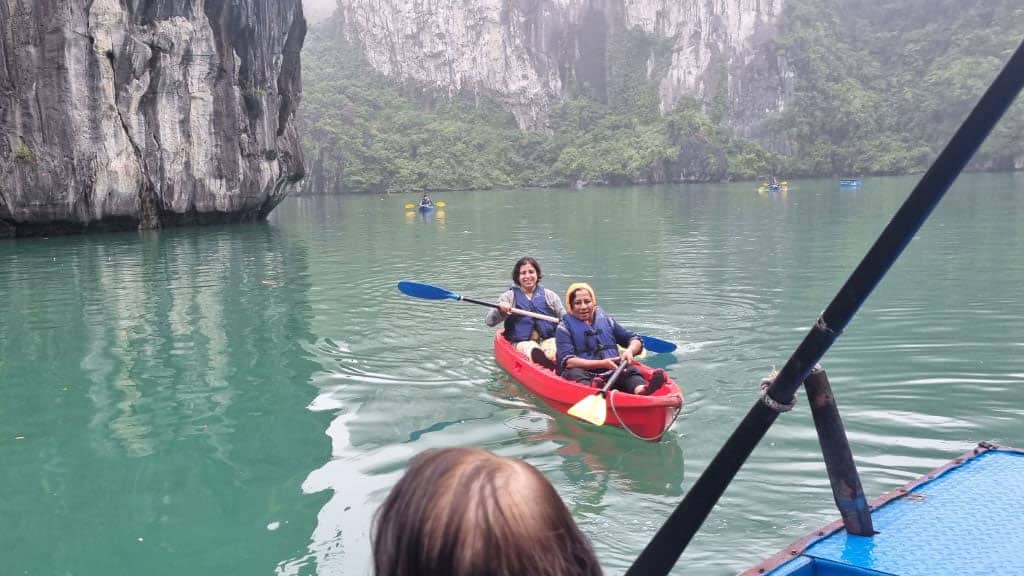
One of the activities planned during our stay at Halong Bay was kayaking. I was excited to try this out for the first time, but my anticipation was tempered with some anxiety. On the day of the activity, each of us was randomly paired with another tour member. I kept announcing to everyone around me that I didn’t know how to swim. I was also apprehensive about maneuvering the boat in the deep waters. The challenge was to steer our way through a low rock arch leading into the bay.
Several questions popped into my head. What if the boat tips over? What if the boat crashes against the rocks?
We were assured that there were lifeguards who would rescue us if we fell into the water, but I still felt unsure.
Schedule a call with a Pragati Leadership expert to discuss how we can support your strategic objectives.
Schedule your CallThen, we were seated in the kayaks. We set about to figure out how to steer the boat in different directions. After a little bit of experimentation, we figured out how to use the oars.
My partner, Sushma, turned out to be a very mature and calm person. While she had never tried kayaking before, she took command confidently. Her instructions were self-assured. Her tone was so calm that all my trepidation vanished. I felt totally at ease under her leadership and told her to take the lead because I trusted her judgment. In the process of following her cues, I became absorbed in the activity itself.
We were in tune and well-coordinated. We not only enjoyed ourselves, but also felt a great sense of achievement on completing the activity. My anxieties were forgotten as Sushma’s calm, commonsensical take on the situation communicated itself to me and enabled me to live in the moment, focusing on steering and also on savoring the new experience.
This experience got me thinking about our work situations.
How can leaders take charge of critical situations in a calm, self-assured way such that their team feels inspired?
What would make people really trust each other so that goals can be accomplished joyfully? Do we trust intimidation or calm assurance?
How can we, as leaders ourselves, practice mindfulness and achieve a sense of control over a situation without seeming harsh and overbearing?
Life is full of situations where we are cast into unfamiliar waters, with unfamiliar tools, and expected to navigate challenging obstacles. This experience made me understand that good leadership defuses anxieties by channelling energy into practical problem-solving, freeing mental space for the joyous sense of participation that makes the difference between another chore ticked off on a list and a real sense of affirmation and accomplishment.
Share on Social Channels
Our Categories
Categories
- Behaviorial (6)
- Blog (240)
- Coaching (8)
- Corporate Trainers (6)
- Developing Collaboration (12)
- Emotional Intelligence Training (11)
- Executive Leadership Program (26)
- First Time Manager Training (10)
- Inspirational Leadership (17)
- Inspiring and Successful Leadership Awards (16)
- Leadership Awards (37)
- Leadership Development (118)
- Leading Virtual Teams (6)
- Management Development (29)
- Marketing (2)
- Negotiation Skills Training (5)
- Organizational Transformation (24)
- Others (24)
- Stakeholder Management (3)
- Strategic Leadership Development Program (3)
- VUCA Leadership (2)
- Wholesome Leadership (23)
- Women Leadership (15)
Recent Insights
Aspiring to be seen as an effective leader? Learn about developing your executive presence (EP);...
Leaders can no longer rely on outdated command-and-control approaches. Looking ahead, we envision a future...
Having a strong leadership pipeline is more important in today’s dynamic environment than ever before....
Congratulations! You have been promoted to a managerial position. This promotion is most likely the...
Leaders in today’s dynamic and fast-paced world need more than technical skills, strategic thinking, and...
